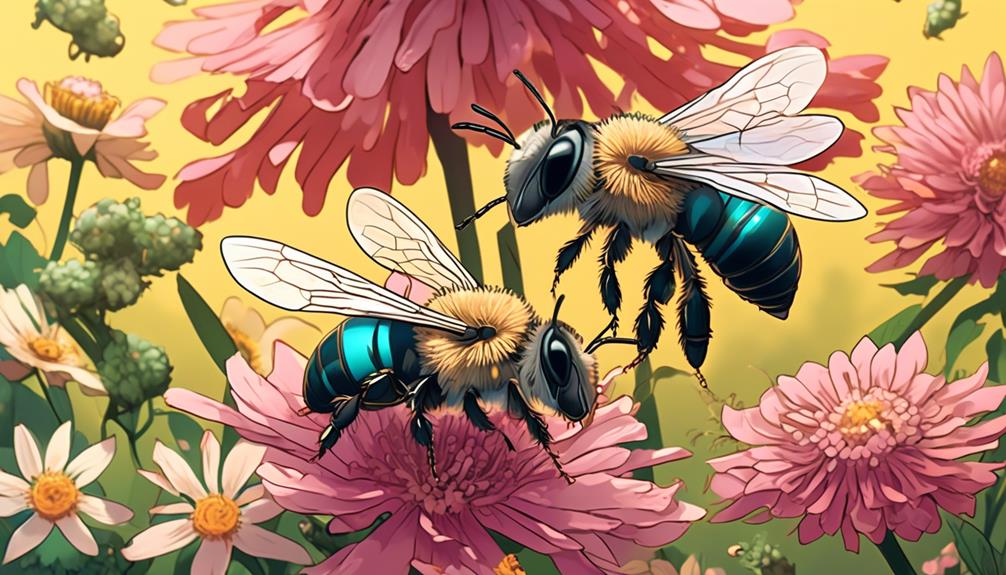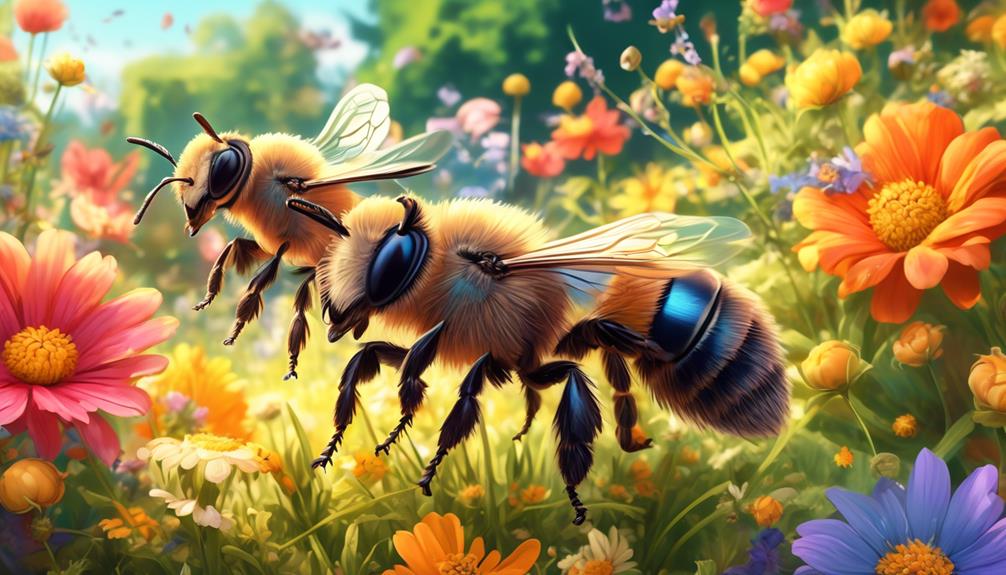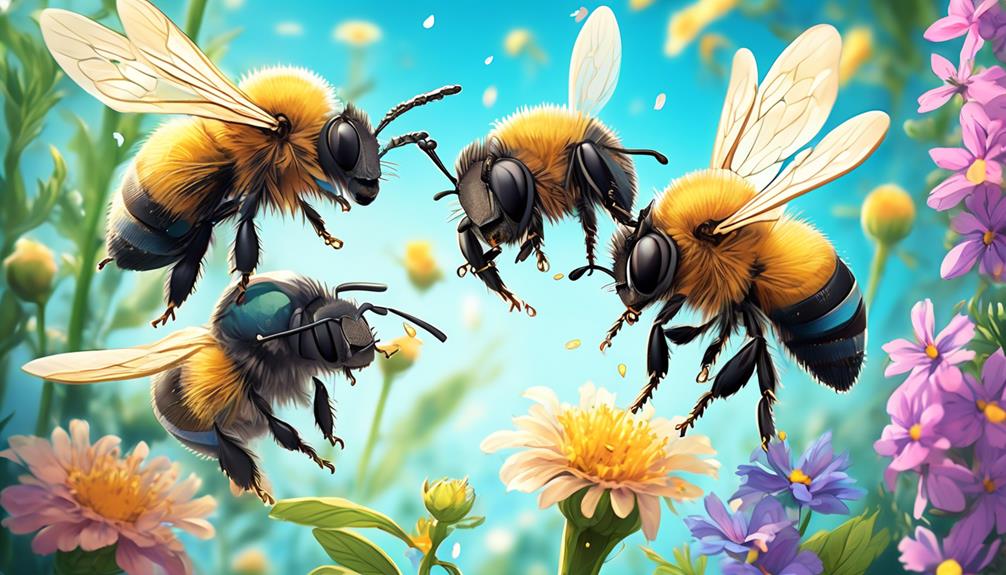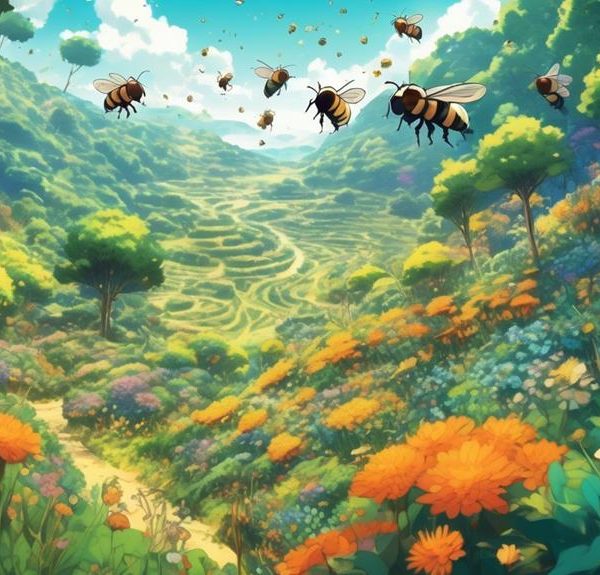Uncover the intriguing dance of mason bees' mating rituals, filled with scent signals and instinctive pursuits, in a world where love letters take flight.

How Do Mason Bees Mate?
Imagine you're in a world where love letters are the norm, but instead of pen and paper, it's all about scent and dance. That's the language of romance for mason bees. They've got a love story that's as intricate as the homes they build, steeped in instinct and survival.
Male mason bees emerge first in the spring, lying in wait for the females. Once a female appears, the chase is on, but what happens next will surprise you. Curious to uncover the secrets of this age-old dance?
Key Takeaways
- Mason bees are solitary creatures, with each female constructing her own nest and laying eggs in small cells.
- Male mason bees engage in competitive behavior, swarming around emerging females to mate.
- Only the fastest and strongest males get the opportunity to mate, and they die shortly after mating.
- Female mason bees have the responsibility of mating, building nests, and providing for their offspring before sealing the nest with mud.
Understanding Mason Bee Behavior

To fully appreciate the mason bee mating process, you'll need to delve into their intriguing behavior patterns, which are as meticulous and precise as they're fascinating. Unlike honeybees, mason bees are solitary creatures. Each female constructs and provisions her own nest, laying her eggs in a series of small cells.
The mating process commences soon after the males emerge from their cocoons, usually a few days ahead of the females. This timing ensures that they're ready and waiting when the females appear. Once the females emerge, the males mate with them almost immediately.
The males, however, aren't merely waiting around. They're territorial, often engaging in competitive behavior to secure the most advantageous positions near the nests. They do this to increase their chances of mating with a female.
After mating, the males die, their role in the lifecycle completed. The females, meanwhile, begin their work: constructing nests, collecting pollen and nectar, and laying eggs. Each cell is provisioned with a ball of pollen and nectar, upon which an egg is laid.
Understanding these intricate behaviors is crucial to appreciating the complexity of the mason bee mating process.
The Mating Ritual of Mason Bees

Having explored the general behavior of these solitary insects, let's now focus on the actual ritual pertaining to the mason bee's mating process. The process begins, interestingly enough, with a race! Male bees emerge from their cocoons before the females, giving them ample time to prepare for the females' arrival. They're ready and waiting as soon as the females begin to appear.
Now, the true spectacle begins. Males swarm around the emerging females in a frenzied competition to mate. It's a sight to behold, but it's also scientifically significant: this initial scramble ensures that only the fastest and strongest males get the opportunity to pass on their genes.
Once a male has successfully mated, his role is completed. He'll die shortly after, having fulfilled his biological purpose.
The female, on the other hand, has a longer journey ahead. After mating, she sets off to find a suitable location to nest and lay her eggs. She'll choose a spot, often a hollow stem or crevice, and begin the painstaking process of creating individual cells for her eggs, each one carefully crafted with mud.
This remarkable ritual highlights the complexity of life within the bee world.
Role of Male Mason Bees

In the grand scheme of mason bee society, the male's primary responsibility lies in successfully mating with a female, an act which marks the culmination and end of his short life. You might find it surprising, but these males are born with one purpose: to pass on their genetic material. And they do it with a sense of urgency, often dying just days after they've fulfilled their purpose.
Here's a brief overview of the life stages and roles of a male mason bee:
Stage | Role | Lifespan |
|---|---|---|
Larvae | Growing | Several weeks |
Pupae | Maturing | Few days |
Adult | Mating | 1-2 days |
As larvae, they're fed by their mothers. Then as pupae, they mature into their adult forms. Upon reaching adulthood, they immediately set out to find a mate. Once the deed is done, their life cycle comes to an end.
This entire process might seem bleak, but it's the reality of male mason bees. They're born, they mate, and they die, all in a very short period. But by fulfilling their role, they ensure the survival and continuation of their species.
Role of Female Mason Bees

Just as important, if not more so, are the female mason bees, who carry the heavy responsibility of not just mating, but also building nests and providing for their offspring.
After mating, the female mason bee seeks out suitable cavities for her nest, often in wood or hollow stems. She'll even make use of man-made structures if they're the right size.
She's a solitary creature, doing all this work alone. Once she's chosen a spot, she begins the painstaking process of creating her nest. Using mud, she partitions the cavity into individual cells. In each cell, she lays a single egg, and provides it with a mixture of nectar and pollen, a food source for the larva once it hatches.
The egg-laying and provisioning process continues until she's filled the entire cavity, which she then seals with more mud. Sadly, her life ends soon after, but her offspring will emerge the following spring to continue the cycle.
This detailed process is a testament to the female mason bee's hard work and dedication. Understanding her role not only enriches our knowledge of these fascinating creatures but also highlights the critical role they play in our ecosystem.
Impact of Mason Bee Mating on Ecosystem

You mightn't realize it, but the mating process of mason bees has a profound impact on our ecosystem. These industrious pollinators mate, lay eggs and then die, leaving behind the next generation to carry on the cycle. Their mating process isn't just about reproduction; it's a crucial ecological service they provide.
Their mating and subsequent pollination activities are directly linked to the health and diversity of our ecosystems. When mason bees mate, they help in the pollination of plants, including many of our food crops. They're more efficient at pollination than honey bees, meaning they can visit and pollinate more flowers in a shorter time span.
But here's the kicker: their populations are declining due to habitat loss, pesticides, and climate change. This decline could lead to lower crop yields and a reduction in biodiversity, affecting the balance of our ecosystems. That's why it's crucial to protect mason bees and their habitats.
Understanding their mating process provides insights on how to support their populations. You can contribute by providing suitable habitats for them, avoiding pesticides, and planting native plants. It's not just about saving the bees—it's about maintaining the health of our ecosystems.
Conclusion
You've seen how mason bees' mating habits impact their ecosystem. Males, emerging first, wait for females to mate.
Females, after mating, commence their vital role as pollinators.
Their mating behavior, while fascinating, also underlines their importance in our ecosystems. Understanding these behaviors helps us appreciate how intricate nature is, and highlights the crucial role tiny creatures like the mason bee play in maintaining the delicate balance of our environment.



